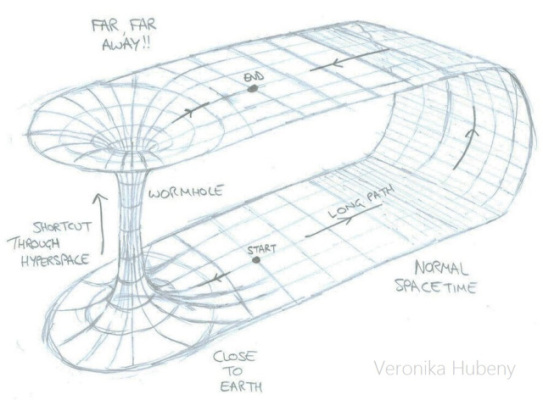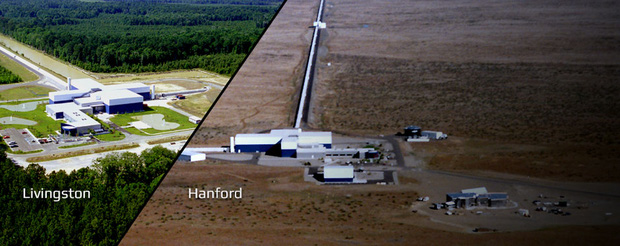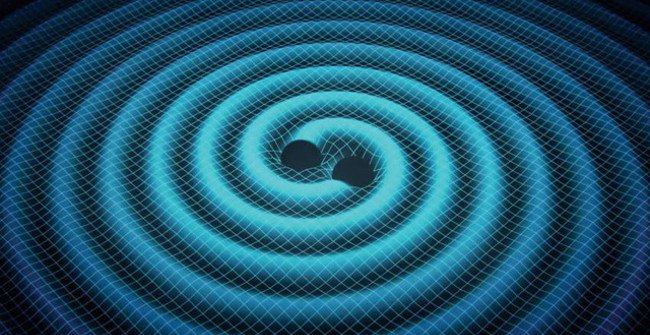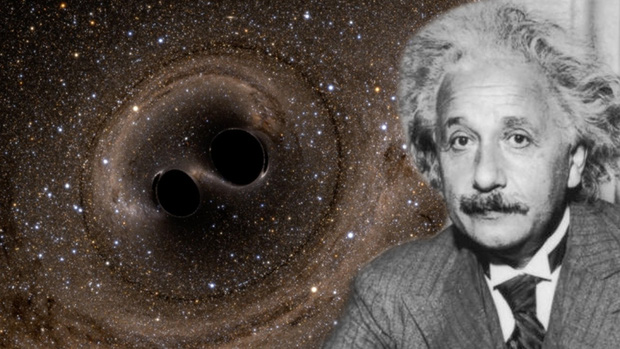Journey to find gravitational waves and unprecedented world discoveries
The 2017 Nobel Prize for Physics was awarded to three scientists for their discoveries of gravity. This work contributes to confirming the 100-year theory of genius scientist Alber Einstein. Let's go back in time to learn about gravitational wave detection and see how important it is for world science.
- The 2017 Nobel Prize for Physics was awarded to research on gravitational waves
- Discovering new gravitational waves from two black holes collides 3 billion light-years away
- Gravitational waves can be the key to revealing the existence of another dimension in the universe
In 1916, Karl Schwarzschild, a German physicist, solved Einstein's tensor equations and found a strange solution whereby around the masses of massive stars have a magic sphere (magical sphere ). Everything that goes into this space will be sucked into the giant star and there is no way to escape, even the light is no exception.
Even Schwarzschild calculated the radius of this virtual book, called the Schwarzschild radius or the gravitational radius.

When Schwarzschild died, he did not know that he discovered something very important that later named John Wheeler Black Hole. There is no ghost book that Schwarzschild found later, scientists called the Event horizon (event hoziron), which means the farthest place that human eyes can observe (after the horizon is a black hole). , where light, if reached, will be swallowed and never returned.

Also in 1916, the great scientist Einstein proposed the existence of a gravitational carrier that spreads in space at a speed equal to the speed of light called coherent waves . By solving his equations, Einstein found waves in theory and made predictions that double stars orbiting a common axis would gradually close together, until the energy was lost due to radiation. Space in the form of gravitational waves they will rush into each other.
In 1936, Einstein and his student Nathan Rosen used the solution of a standard black hole with a long-necked neck that was cut off and merged with a similar black hole but turned around. Today, cosmologists visualize this idea as a portal to connect two different universes and are called Einstein-Rosen Bridge or wormhole. But Einstein believed that wormholes might exist, but the organisms that entered the mouth of the black hole would be instantly torn apart by gravity.

In 1963, Roy Kerr, an Australian mathematician found the exact solution of Einstein's equation: when a star dies, its own gravity causes it to collapse into the interior, turning faster due to the law of conservation dynamics. amount and form a rotating black hole.
Roy Kerr's test showed that the passage of the wormhole to escape to another dimension was theoretically possible: centrifugal force (outwardly) due to the rotation of the black hole would balance and cancel the force. attractive (sucking in), this helps the creatures fall into the mouth of the black hole will not be torn apart anymore.
Because the black hole is invisible because it absorbs all the light that passes through it, so the astronomer has to rely on the accretion disks (accretion disk) made up of the accretion gas around the black hole to identify black holes.
It was not until 1994, clear evidence of superheavy black holes in the middle of the Hubble telescope's new galaxies. Astronomers believe that our Milky Way, like most galaxies, has black holes in the center. Today there are hundreds of black holes discovered in the universe and they all spin very quickly around themselves.
In 1984, three scientists Kip Thorne, Ronald Drever and Rainer Weiss formed an interim committee to build the LIGO project to find gravitational waves.
In 2002, LIGO started operation.
In 2015, Advanced LIGO, a more modern version began looking for gravitational waves.
LIGO (Laser Interferometer Gravitational Wave Observatory) - Gravitational wave monitoring station laser interferometer is a giant L-shaped device consisting of two pipes about 4 km long connected together. In each tube, a laser beam is projected continuously, the two beams meet at the angle of the L. The scientists calculated so that the laser waves cancel each other out and create the interference pattern. Due to polarization, two tubes are perpendicular to each other, so only one tube is struck by gravitational waves. Then, the length of this tube will be different from the other tube, causing disturbance to break the balance of the two laser beams, and lose the interference pattern.
 Two LIGO stations in Livingston and Hanford (USA).
Two LIGO stations in Livingston and Hanford (USA).
According to calculations, LIGO may have to wait 1 to 1000 years to detect the collision of two black holes 300 million light-years from Earth. Luckily, after being upgraded for several hours after the Advance LIGO discovered the collision of two black holes 1.3 billion light-years from Earth.
Gravitational waves also have the same amplitude, frequency, wavelength and speed as other types of waves. The speed of gravitational waves is equal to the speed of light, their frequency is very low, so the wavelength is very long and the energy is low. Therefore it is very difficult to catch gravitational waves.

In a distant galaxy, 1.3 billion years ago, two black holes were caught in a spiral orbit, and at the last moment they crashed into each other at nearly the speed of light. A new black hole was created after the collision. It weighs 62 solar masses and emits a huge amount of radiant energy into the universe in just a fraction of a second, causing the space and time around the collision to deform in the blink of an eye. Because the collision occurs between two black holes, the energy emitted is gravitational waves, not light waves.
This gravitational wave travels and causes space to expand as it passes. This is space - time in Einstein's universe.
On February 11, 2016, LIGO scientists announced they had detected waves from a merger of 1.3 billion light-years away, which is gravitational waves.
June 15, 6, the second time LIGO announced the detection of gravitational waves from a black hole merger 1.4 billion light years from Earth.

LIGO's gravitational wave detection proved Einstein to continue to be right in the gravitational aspect of his general theory of relativity. For the first time gravitational waves have been demonstrated with experimental evidence of a phenomenon occurring outside the solar system.
The gravitational wave detection of LIGO for the first time helps science directly prove by experimenting with the existence of a pair of black holes, which exist only theoretically. From the measured LIGO data, the scientists discovered the mass of the black hole, the orbital velocity, and the time when two black holes crashed into each other. They hope, these data also help explain the formation of superheavy black holes at the center of galaxies.
You should read it
- Discovering new gravitational waves from two black holes collides 3 billion light-years away
- This is a photograph of the first black hole of mankind, located in a galaxy 55 million light-years from Earth
- black hole, white hole, deep hole
- Successfully creating cosmic black holes, demonstrating Hawking radiation exists
- The first 'wandering black hole' was discovered, 7 times as massive as the sun, and it took scientists 6 years to observe it
- What happens when the Earth falls into a black hole?
- Hubble begins its hunt for hard-to-identify medium-sized black holes
- Astrophysics professor teaches how to jump into a black hole so it's 'safe' and possible events
May be interested
- Top best selling Xiaomi travel cameras 2020
 with outstanding advantages in design and features, the top 5 best selling xiaomi dashcams in 2020 below are great options for you.
with outstanding advantages in design and features, the top 5 best selling xiaomi dashcams in 2020 below are great options for you. - How to play Co-op Wuthering Waves, Wuthering Waves co-op
 co-op mode in wuthering waves is quite necessary because players can form a team to hunt bosses and train monsters much easier than going individually.
co-op mode in wuthering waves is quite necessary because players can form a team to hunt bosses and train monsters much easier than going individually. - Unexpected things in the house silently 'break' Wi-Fi waves
 fish tanks, decorative flashlights and many other household items affect the quality of wi-fi waves. what is the cause and how to fix it?
fish tanks, decorative flashlights and many other household items affect the quality of wi-fi waves. what is the cause and how to fix it? - Scientists are increasingly interested in warp engines, which 'space distortion' technology allows us to travel at the s
 warp engines - the strange thing is that this motive is possible and doesn't seem to violate physical rules.
warp engines - the strange thing is that this motive is possible and doesn't seem to violate physical rules. - What is gravity? What is gravity?
 what is the gravitational force of the earth? the more massive an object is, the more gravitational force it has? this article will give you the answer.
what is the gravitational force of the earth? the more massive an object is, the more gravitational force it has? this article will give you the answer. - Journey Facebook becomes the world's largest social network
 before becoming the highest-ranking social network with 2 billion users and a market capitalization of nearly $ 500 billion, facebook was born in a dorm room at harvard university. join us to find out how facebook's journey becomes the world's largest social network!
before becoming the highest-ranking social network with 2 billion users and a market capitalization of nearly $ 500 billion, facebook was born in a dorm room at harvard university. join us to find out how facebook's journey becomes the world's largest social network! - Researchers invented a method that allows playing a puzzle game through brain waves
 this interesting gaming interface is named brainnet.
this interesting gaming interface is named brainnet. - Tips 'mental arithmetic' you can't find in textbooks
 learn fast calculation methods, mathematical rules that you can't find in textbooks or in school chairs ...
learn fast calculation methods, mathematical rules that you can't find in textbooks or in school chairs ... - First confirmation in the world: Having a brain tumor caused by using too many mobile phones
 the court in italy has recently concluded that a man has been suffering from a brain tumor due to excessive use of mobile phones.
the court in italy has recently concluded that a man has been suffering from a brain tumor due to excessive use of mobile phones. - How to download and play Wuthering Waves PC
 although it is a mobile game, wuthering waves is also worth experiencing on computers.
although it is a mobile game, wuthering waves is also worth experiencing on computers.










 Close up of the star is said to be a giant structure of aliens
Close up of the star is said to be a giant structure of aliens After all the mysterious material that occupies more than half of the universe hidden for billions of years has been discovered
After all the mysterious material that occupies more than half of the universe hidden for billions of years has been discovered Sign up now and always with NASA to be SIGNED ASKED
Sign up now and always with NASA to be SIGNED ASKED NASA declares the existence of the 9th planet in our Solar System
NASA declares the existence of the 9th planet in our Solar System For the first time in history, people witnessed two merged neutron stars creating gravitational waves
For the first time in history, people witnessed two merged neutron stars creating gravitational waves How far is the Earth from celestial bodies in the solar system?
How far is the Earth from celestial bodies in the solar system?